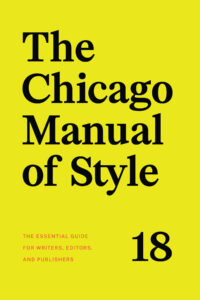The New Chicago’s Here! The New Chicago’s Here!
 After years of waiting, the 18th edition of The Chicago Manual of Style is here, and it brings some big changes, starting with the electric yellow cover. But don’t worry—the familiar orange is still there on the spine. (Though Carol Fisher Saller once informed me that the official Pantone color is technically called “warm red.”) Inside, you’ll find new guidance on inclusive language, electronic publishing, self-publishing, editing fiction, AI, new media, and more. You can check out this handy list of the most significant changes for more details.
After years of waiting, the 18th edition of The Chicago Manual of Style is here, and it brings some big changes, starting with the electric yellow cover. But don’t worry—the familiar orange is still there on the spine. (Though Carol Fisher Saller once informed me that the official Pantone color is technically called “warm red.”) Inside, you’ll find new guidance on inclusive language, electronic publishing, self-publishing, editing fiction, AI, new media, and more. You can check out this handy list of the most significant changes for more details.
I haven’t had a chance to look through all the updates yet, but I hope to post a more thorough review soon. In the meantime, the staff at the University of Chicago Press were kind enough to let me send a few questions to Russell Harper, the editor of The Chicago Manual of Style Online Q&A and the CMOS Shop Talk blog. He has served as principal reviser of the last three editions of the Manual, including the newly published 18th. His responses are below.
Do you have an overarching philosophy when approaching new editions, and if so, how has it changed with the 18th edition?
There’s no overarching philosophy—no mission statement or anything like that—but we do need to keep up with the times. Every new edition is also an opportunity to refine the existing rules to make them as clear and as comprehensive as they can be. There were eleven editions between 1906 and 1949, partly to update all the typeface samples, which in those editions—in the era of metal type—took up half the book. Then in 1969 the 12th edition was published, and the type samples were dropped. That’s when computers were entering the picture, mainly in the context of typesetting, though the word “computer” wasn’t mentioned in the Manual until 1982 (in the 13th edition), the same year the word “Chicago” became part of the title. Since then, technology has been the main driver behind every new edition. We might still be using the 12th edition if not for computers and all that followed, from the internet and Unicode to URLs and DOIs and ebooks and social media. It’s not as if commas and semicolons have changed. Still, the 18th edition is the first to mention comma splices, a term that had been around since the 1920s but didn’t seem to get much attention from copyeditors until more recently. And we now advise our readers that authors may reject the use of semicolons in fictional dialogue—a small point, but it’s something editors should know. The 18th edition is also the first to cover emojis—mainly in terms of Unicode but also relative to sentence punctuation. There are several other firsts in the new edition, but for any concept to make it into the Manual, it has to be something that writers and editors might encounter as they get their words and images ready to publish. If the 18th edition is different, it’s that we know more than ever about how this work is done and which issues are likely to need a rule or recommendation—partly because the technology that we use to have conversations with each other is now essentially the same as the technology we use to write and edit and publish and all the rest.
The 17th edition still cautioned against generic singular “they,” which was gaining traction but was still heavily debated at the time. Were there any issues that inspired a great deal of debate among the editors of CMOS with this edition?
Our decision to refer, for example, to The New York Times instead of the New York Times—that is, treating an initial The as part of the name of a periodical that includes it on its masthead or cover—inspired a lot of debate. But the fact that the many academic journals published by the University of Chicago Press were already making this distinction when writing about themselves (as on their About pages) helped to tip the balance toward making the change. There was also a lot of back and forth about prepositions in titles. A few of our advisers wanted to stick to the traditional rule—even to the point of retaining lowercase for a phrasal preposition, as in The World according to Garp—but mostly the debate was about whether to set a three- or four-letter limit. We ended up settling on four, as in “The Trouble with Tribbles” (the Star Trek episode) but Much Ado About Nothing (Shakespeare), which was a less drastic change. But that also accords with what one would tend to find online, including at sources like Wikipedia and Britannica, where many people go to check titles (at least initially). Anyway, we tallied opinions, and that’s where we ended up.
Many editors have rejoiced at being able to drop the place of publication from source citations. Are there any changes that you are particularly excited about?
No single change stands out as unequivocally exciting, but we know from the responses we got along the way that some changes were more popular than others. Our endorsement of generic singular “they” had this effect; editors especially were happy to know they didn’t have to continue to revise that word out at all costs. And the new The rule for the names of newspapers and other periodicals seemed to make more than a few people happy—at least judging from the comments made by our reviewers in successive drafts of the manuscript for the new edition—but there were also a few who were unhappy about that change. Any change that aligned our recommendations with what people were already doing seemed to be mostly popular while generating at least some dissent. There’s always this tension between the rules, which can seem arbitrary, and actual practice, which tends to be where rules are adjusted to fit reality. And now that everyone can look things up with their phones, any shift that aligns with actual practice is likely to gain traction.
The grammar chapter is the longest in the book and includes topics that have inspired much recent debate. Can you tell us how you approached the revision of this chapter?
We worked with Bryan Garner to include the concept of prescriptive versus descriptive grammar in the introductory paragraphs to chapter 5 while also acknowledging that Standard English is only one variety of English—though it happens to be the one most commonly encountered in published prose. This was part of a broader effort in the new edition not only to address concepts related to inclusive language but also to acknowledge the difference between formal and conversational registers wherever applicable, which is also an important aspect of our new coverage of fiction and related genres. We also know that a working knowledge of grammar is essential especially to copyeditors and that they need a way of referring to the subject that isn’t too technical or academic. The fact that our readers can go to Garner’s Modern English Usage for more information without having to learn an entirely different vocabulary was part of that goal.
One change that surprised me is that a year at the beginning of a sentence doesn’t need to be spelled out anymore (as in “2020 was a good year for clairvoyants”). What other changes do you think may be a bit of a shock to longtime users of CMOS?
Some people are still getting over the fact that we don’t recommend more than one space between sentences. But seriously, the The in periodical names will be a shock to some; that rule had stood since the first edition. And some users may be surprised by the advice to capitalize a grammatically complete sentence introduced by a colon (if so, they could always use more semicolons instead of colons). Even our endorsement of generic singular “they” may cause a bit of grumbling in some corners of the universe. But we hope that each change, however much it might depart from previous editions, brings an increased awareness of what’s at stake when applying Chicago style. Are rules something to enforce no matter what, or a starting point for consistency that can be adjusted to suit context? Will readers understand what an author is trying to say? When is it OK to depart from how things are usually done? We hope we’re getting closer to striking the right balance, while helping writers and editors do all those things that make the difference between published prose and everything else.
The 18th edition of The Chicago Manual of Style is available now. And if you order it from the CMOS Bookstore, you can get 30 percent off with the coupon code FANCLUB18. That’s cheaper than what you’ll find on Amazon, even when you include shipping. And for the CMOS superfans out there, there’s also a merch store where you can buy T-shirts, mugs, throw pillows, and even a skateboard. Check it out!
I receive no compensation for any purchases you may make. I’m shilling for free because I’m just that big a fan.

Deborah Cameron
Well, speaking as someone whose main view on the CMOS is “all the other options are worse” I confess I’m shocked to discover this person thinks there’s no difference between colons and semicolons
mike
I didn’t get that from what he said, since he had an “instead”: “the advice to capitalize a grammatically complete sentence introduced by a colon (if so, they could always use more semicolons instead of colons).”
Dawn Loewen
Thanks for this! I’m surprised Russell didn’t point out that the change regarding a year at the beginning of a sentence is a bit more nuanced: “Years, which are almost always expressed as numerals and which can be unwieldy when spelled out, may begin a sentence if necessary (a departure from previous editions of this manual, which advised spelling them out when rewording was not possible). It is usually preferable, however, to reword.”